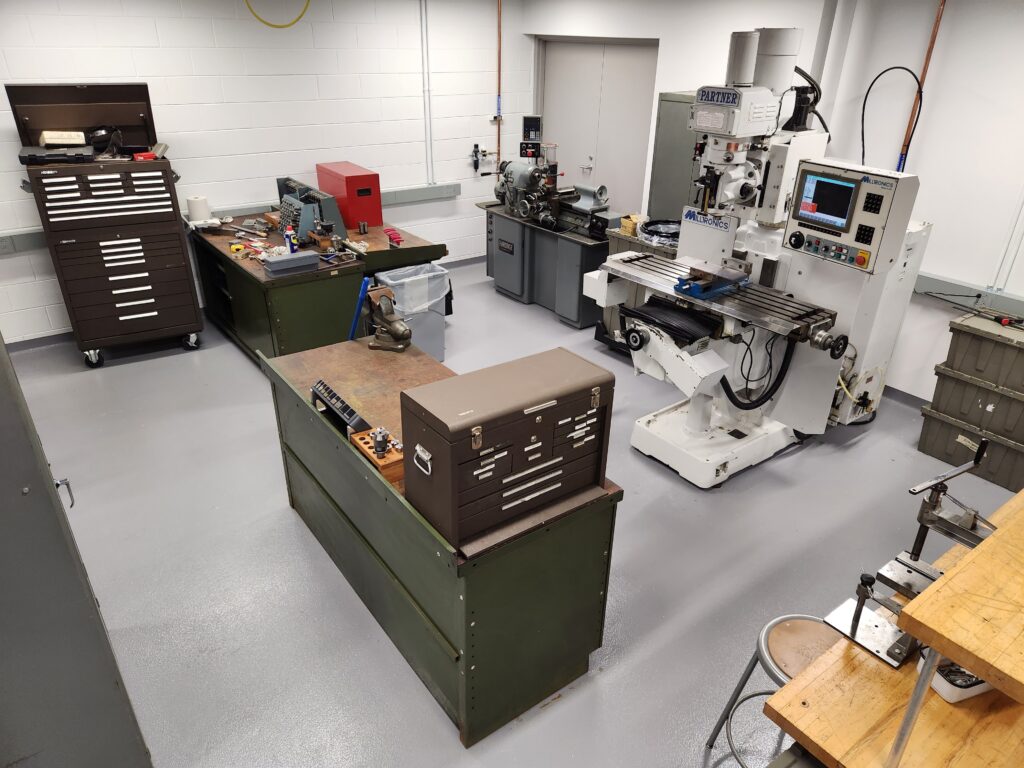The James T. Neubacher Award, which is sponsored by the U-M Council for Disability Concerns, the Equity, Civil Rights, and Title IX Office, University Human Resources, Michigan Medicine, and the Office of the President, recognizes significant achievements in empowering people with disabilities, advocating for or advancing disability rights or disability justice, and increasing the accessibility of programs and services to promote disability inclusion.
This year, Don Wirkner, ME’s Instructional Lab Services Manager, has received an honorable mention for this award in recognition of the work that he and his team have done to promote accessibility in ME labs, which provide creative, fabrication, and hands-on learning environments for ME students and are critical to the department’s educational programs. Below, Wirkner details the work that has gone into identifying accessibility problems in industry standard equipment setups and how his team came to address those problems.
Part of your work that was recognized with this honorable mention was the identification that “standard industry equipment in fabrication labs do not allow full participation by all students of various stature and physical abilities.” First of all, what is a fabrication lab? What kind of work goes on in one?

Don Wirkner: Our fabrication spaces allow students in our design courses to be creative and transform raw materials into projects shaped to perform a specific function. Students build robot machine players (RMPs) in ME250, motor driven mechanisms in ME350, and any number of project types in their senior capstone design course. Students operate machines to cut and shape metals and plastics, then assemble the pieces into functional prototypes.
What kind of equipment did you and your team determine wasn’t really accessible? What was at issue in the standard setups?
Don Wirkner: The two most popular machines in our shop are milling machines and lathes. Milling machines are tall machines that shape metals or plastics in three dimensions, and are used for holes, pockets, and slots. Based on 100 year old designs, the control switches, levers, and interactive pieces are generally positioned for a 65 – 70” tall individual. Lathes are used to shape round parts and are a bit more low profile in size, but several controls and interfaces were tough for some people to reach. We had observed that shorter stature students had trouble reaching certain controls and we had several raised platforms available to assist. Students in wheelchairs are even more limited in horizontal and vertical reach, and this triggered us into action.
Kemal Duran, a Design Instruction Engineer in U-M ME, and I developed criteria and assessed each machine control lever, knob, and switch for reach, maneuverability and manipulation. This was our attempt to understand if a student could physically get to and operate each function successfully. Kemal and I, along with Mike Klein, an Engineering Technician in U-M ME, came up with proposed solutions. Some were simple, while some were extremely difficult or expensive. We ultimately came up with estimates to make the changes we were proposing, and planned a tiered multi-year approach. My goal was to implement many changes within three months – to be ready for fall semester 2023. We implemented the highest use and easy solutions first, with plans to ask for additional funding in the future.
And how are your labs different now because of the work your team has put into them?

Don Wirkner: On the milling machines, we lowered the motor on/off switches, and tool changer controls. We also put the digital readout (this tells you the location of the table axis) on an adjustable monitor mount – and it has in/out, up/down and swivel capability. The lathes received the adjustable mount for the digital readout, and one lathe got an extended control panel, moving the switches and dials for those in wheelchairs. Mike Klein did some fantastic work and our ability to fabricate custom parts (hey, it’s a machine shop after all!) saved us a bunch of money. We also ordered some adjustable height tables for several labs, and swapped out large tables for smaller ones for increased aisle space in two labs.
For many students, the changes are transparent – since the solutions are more universal, they actually work well for most users. We do have to demonstrate the adjustability of certain functions – but students appreciate it once they see how it works.
Looking forward, what comes next? Are there other problems that you and your team are looking at and want to address next?
Don Wirkner: We have learned that every individual is different, and every disability is different, or requires a different solution. That is what makes inclusive design a challenge and a moving target. We struggled to develop design criteria to determine our understanding on what optimized solutions should look like. However, each step that we take to increase accessibility allows more full participation by ALL students. Engineering is for everyone – and each of us can make small changes to ensure the process of learning is a little easier.
Read more about the James T. Neubacher Award, and about this year’s recipient, Pam MicGuinty, on the award page and at the University Record.